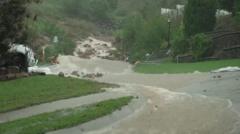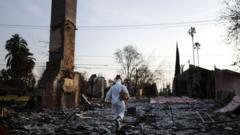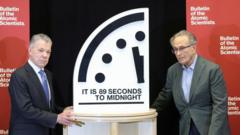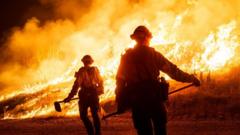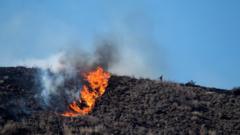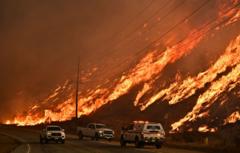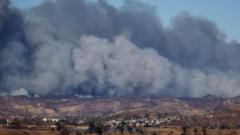After nine days of relentless struggle against two major fires, Los Angeles firefighters see improved conditions as winds ease.
**Respite in Los Angeles: Weaker Winds Aid Firefighting Efforts**
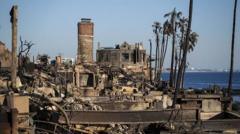
**Respite in Los Angeles: Weaker Winds Aid Firefighting Efforts**
Firefighters receive a crucial break as strong winds diminish in Southern California.
The fierce hurricane-strength winds that have plagued Los Angeles, exacerbating fires for the past nine days, are starting to weaken, giving much-needed relief to weary firefighting teams. This change in weather conditions marks a pivotal moment in the battle against the devastating blazes that have combined to scorch approximately 40,000 acres of land.
The two largest fires, the Eaton and Palisades fires, have taken a dreadful toll, resulting in at least 25 fatalities and the destruction of more than 12,000 structures within the sprawling metropolis. The situation led officials to seek additional firefighting assistance from neighboring countries, including Canada and Mexico, as they strive to combat these destructive infernos.
While the National Weather Service has lifted red flag warnings, they caution that the threat is not entirely behind them. “We expect a significant improvement tonight and into tomorrow, but areas of concern remain,” remarked Ryan Kittell from the NWS to AFP. The winds are predicted to ease, resulting in higher humidity levels, which can help firefighters' efforts. However, they warn that the Santa Ana winds, renowned for intensifying wildfires, could make a return early next week, prompting fears of new red flag warnings along with gusts reaching up to 50 mph.
Currently, the Palisades Fire, which is the more extensive of the two, has been stable in its spread with about 20% containment reported as of Thursday morning. Fire incident manager Jim Hudson noted, “There are still extreme hazards and heat within the fire's perimeter.” Reports indicate that around 5,100 personnel are tirelessly working to secure the containment of this fire.
The grim toll from the fires has not gone unnoticed. Earlier this week, the LA County Medical Examiner's Office confirmed the 25th death linked to these fires, while several others remain unaccounted for. Most victims have been tied to the Eaton Fire, which has consumed over 14,000 acres north of Los Angeles, with firefighters managing to contain 45% of its spread. Despite the challenges, residents in some affected areas have begun to return home under night-time curfews, although tens of thousands remain on mandatory evacuation orders.
The ongoing crisis has led climate scientists at 'Climameter' to point to human-induced climate change as a significant contributing factor. Their findings indicate that current atmospheric conditions favor wildfires—being warmer, drier, and windier than historical averages. As these California wildfires continue to escalate, the conversation around climate-related risks and natural disasters is more pertinent than ever, with ongoing research shedding light on the underlying causes of such catastrophic events.
The two largest fires, the Eaton and Palisades fires, have taken a dreadful toll, resulting in at least 25 fatalities and the destruction of more than 12,000 structures within the sprawling metropolis. The situation led officials to seek additional firefighting assistance from neighboring countries, including Canada and Mexico, as they strive to combat these destructive infernos.
While the National Weather Service has lifted red flag warnings, they caution that the threat is not entirely behind them. “We expect a significant improvement tonight and into tomorrow, but areas of concern remain,” remarked Ryan Kittell from the NWS to AFP. The winds are predicted to ease, resulting in higher humidity levels, which can help firefighters' efforts. However, they warn that the Santa Ana winds, renowned for intensifying wildfires, could make a return early next week, prompting fears of new red flag warnings along with gusts reaching up to 50 mph.
Currently, the Palisades Fire, which is the more extensive of the two, has been stable in its spread with about 20% containment reported as of Thursday morning. Fire incident manager Jim Hudson noted, “There are still extreme hazards and heat within the fire's perimeter.” Reports indicate that around 5,100 personnel are tirelessly working to secure the containment of this fire.
The grim toll from the fires has not gone unnoticed. Earlier this week, the LA County Medical Examiner's Office confirmed the 25th death linked to these fires, while several others remain unaccounted for. Most victims have been tied to the Eaton Fire, which has consumed over 14,000 acres north of Los Angeles, with firefighters managing to contain 45% of its spread. Despite the challenges, residents in some affected areas have begun to return home under night-time curfews, although tens of thousands remain on mandatory evacuation orders.
The ongoing crisis has led climate scientists at 'Climameter' to point to human-induced climate change as a significant contributing factor. Their findings indicate that current atmospheric conditions favor wildfires—being warmer, drier, and windier than historical averages. As these California wildfires continue to escalate, the conversation around climate-related risks and natural disasters is more pertinent than ever, with ongoing research shedding light on the underlying causes of such catastrophic events.

